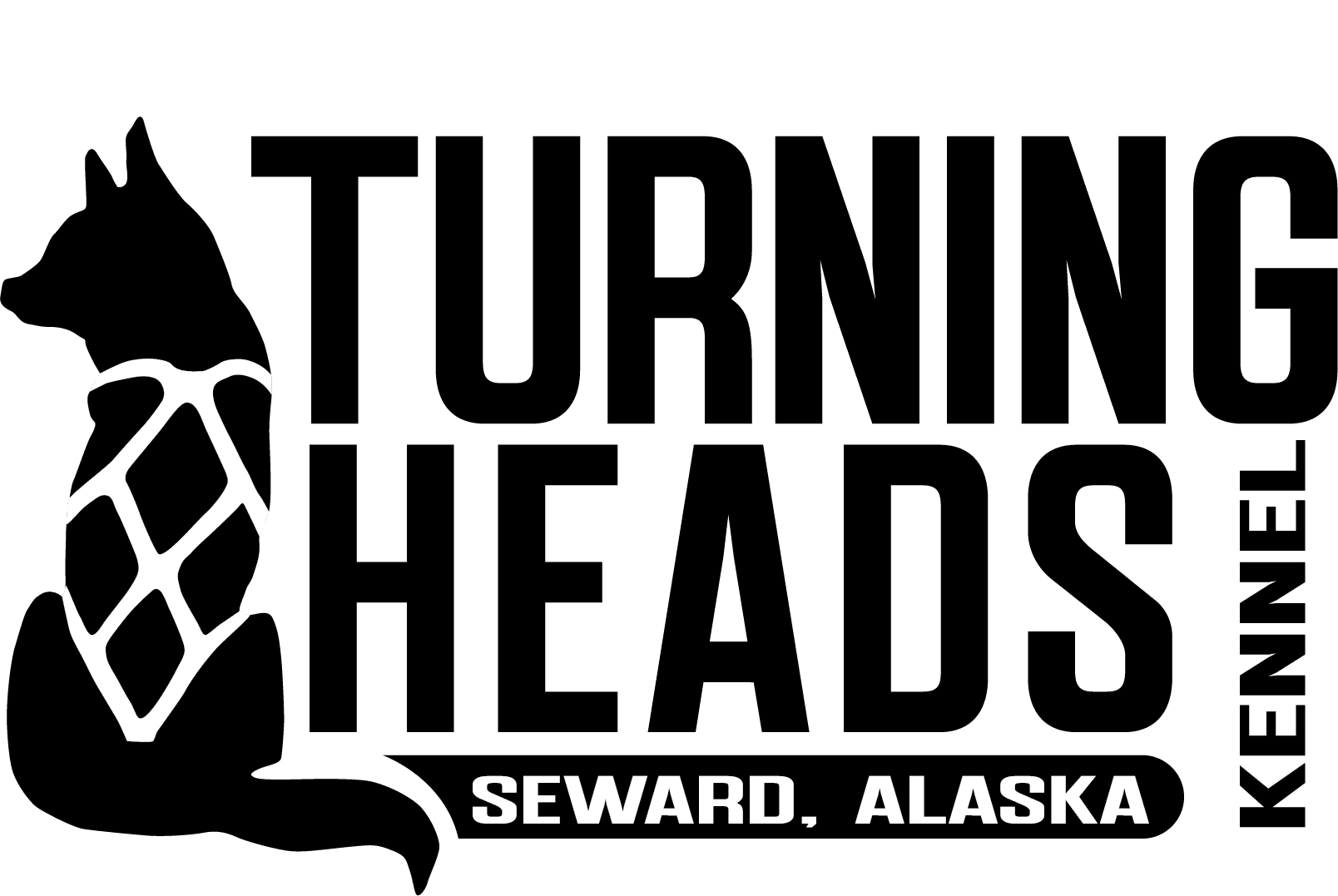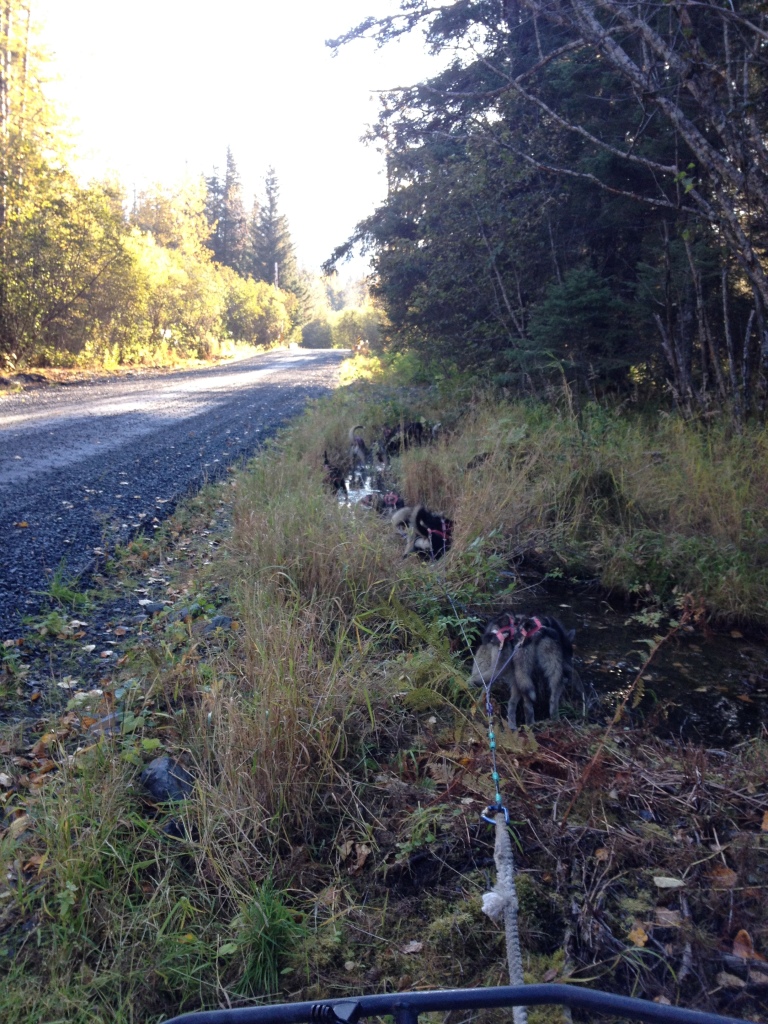Sled Dog Care Part 1 — A look at Housing & Caring for Sled Dogs
This is the first article in a two part series about how we take care of our sled dogs both at home and out on the trail.
We love our dogs and strive to take the best care possible of them. To us, our dogs are family. We are not alone in this philosophy: mushers run dogs because we love dogs and when you love something, you take excellent care of it.
Owning sled dogs is a huge commitment. Like any animal, they require lots of attention every single day and so, in many ways, we give up a good deal of freedom. We choose to do this because we love our animals and the lifestyle we share with them.
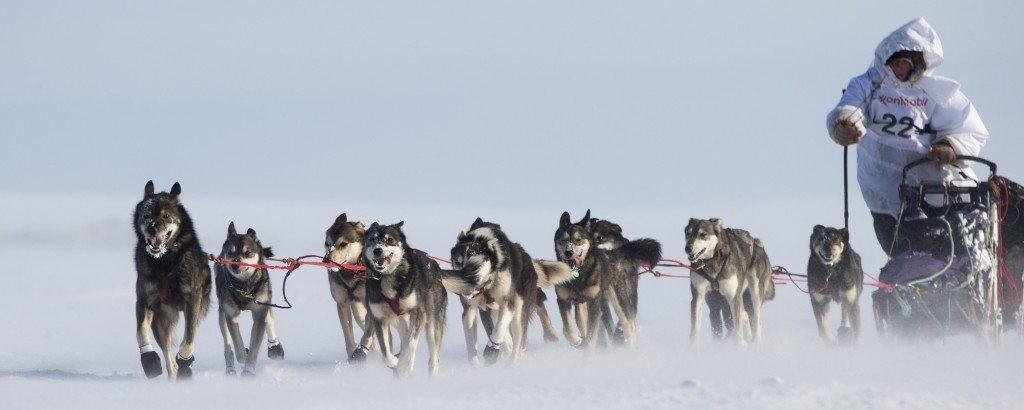
Good sled dog care happens both at home and on the trail and its important to have both. We feel really honored that Travis has now been the recipient of two humanitarian awards, given for best dog care, by both the Tustumena 200 and the Copper Basin 300 sled dog races.
A Glimpse At Our Kennel: Sled Dog Care in The Dog Yard
When you walk into our dog yard you will notice two things. The first is that we have a lot of dogs who live at brightly colored houses. The second is that they aren’t making any noise. That’s because our dogs have their needs met: they have shelter, food, water, and, most importantly, lots of love and attention. Because we provide sled dog tours for a living, we are able to work with our dogs full time. I couldn’t think of better, happier co-workers!
Most mushers have between 30-100 dogs — seeing so many dogs at once can be overwhelming if you have never experienced it. We have 55 dogs and are leasing another 10 this year from musher Louis Ambrose. Our dogs are all friendly and generally speaking we allow our guests to interact with whichever dogs they would like.
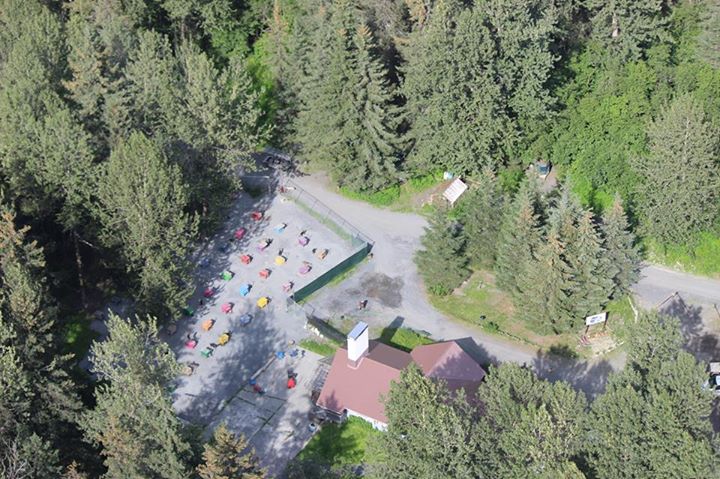
Many people wonder why sled dogs live outside year-round. The main reason sled dogs live outside is that they are highly adapted for living outside in cold weather climates. While many of our dogs spend time in our home on a rotational basis, they generally get too hot and need to go back outside after a few hours. Imagine if you had to wear your parka inside all day long when it was 70F out — you’d get pretty uncomfortable after a while too! Throughout the summer and fall, our dogs hardly use their houses, preferring to sleep outside even in the rain.
Tethering Sled Dogs
Outside, our dogs are on tethers or in pens. Generally speaking, we space our dogs so they are close enough to play. We supplement this by routinely letting the dogs have free-time in our fenced in yard. We are currently working on building another large pen so that our dogs can enjoy greater freedom and more space to roam and play together. It is important to our philosophy as a kennel that our dogs have plenty of time to be dogs and have decided that building large enclosures where they can run around, play, and interact with their teammate is important to us.
Tethering sled dogs is a routine practice. Although many people are uncomfortable with the idea of tethering dogs, sled dogs receive so much exercise and care, it is important for each dog to have their own spot to call home where they can rest in relax. Cornell University published a paper saying that keeping sled dogs in pens showed no benefit over keeping them on tethers. You can read that study here, if you’d like. Nancy Russell also wrote a wonderful short article called “the positive effects of tethering.”
We tether most of our dogs but have pens for our puppies, who are not yet pulling sleds, and our females in heat. We would like to have more pens available for our older dogs in the future and hope to work on that this coming spring. We have also purchased two large dog carousels, but have lacked the time and resources to get it put together. This will be one of our springtime projects!
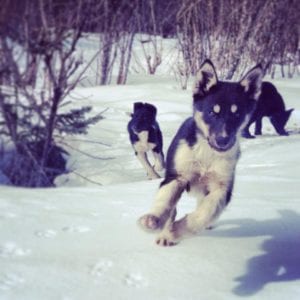
Our young dogs generally run loose through the yard when we are not doing tours; this helps socialize our puppies with the rest of the kennel while also providing playmates for our older dogs.
Keeping Sled Dogs Inside
Even though sled dogs don’t always enjoy being inside, sometimes we have to bring them in. Last fall, I built a 10-hole dog box for our basement. We’ve used it numerous times to bring in sick or injured dogs, young dogs who we want to spend more time with, or if the weather is particularly bad.
Here in Seward, it generally does not get cold enough where we would want to consider bringing our dogs in. Mushers who live further north sometimes see temperatures of -40, -50 and even -60 below! While sled dogs are adapted to the cold, many mushers who live in these areas have “dog barns” where they can bring their dogs inside. Aliy Zirkle and Allen Moore of SP Kennel live in Two Rivers Alaska where it can get quite cold and have a dog barn they use. Check out their dog barn! Mike Santos of Wolf’s Den Kennel also makes use of a dog barn though his set up is quite different from SP Kennel’s. Check out Mike’s dog barn!
Although we do not have cold temperatures that warrant brining our dogs inside, we do receive lots of rain. Occasionally we get lots of rain at 33F. While our dogs are well adapted to the cold, no one likes to be wet and cold. If we need to, we can actually bring all 65 of our dogs out of the rain. We have spots in our basement, dog trailer, and truck to accommodate every single dog.
A number of our older all-star lead dogs such as Zema, Tamere, Boston and Madison are also familiar with inside living so they can be loose. When we bring the four of them in with our 4 pet dogs who already live inside, real mayhem can occur!
Being able to bring all our dogs inside is important. We learned in 2012 that we need to have an evacuation plan in place for our kennel because we can experience extreme flooding. Most of our dogs are able to go in dog trucks or trailers so that should we need to move our dogs to higher ground quickly.
Remember the flood? We sure do. Being adequately prepared for another flooding event has been important to us.
Musher undeterred by Seward flooding from anchoragedailynews on Vimeo.
Sled Dog Care: Taking Care Of Dogs
What proper sled dog care looks like in the kennel varies from musher to musher, kennel to kennel but these are some of the things that are important to us. We believe most mushers would agree that these are good standards of care.
A Clean Yard
At the kennel, proper dog care comes in the form of scooping the yard on a regular basis. We often scoop the yard 2-3 times a day. The cleaner the dogyard, the better! A clean dog yard is important for the health and well being of our dogs.
No standing water
This should go without saying but it is important. Standing water is a breeding ground for bacteria and infection. No thanks! While less of a problem in the interior part of Alaska, in Seward where we can see inches of rain per day having effective draining systems is crucial and has taken lots of time and money.
We put in thousands of dollars worth of gravel each spring, only to have September roll around and expose a new “low spot.” We will always have to worry about flooding but we can counteract problems that routine rainfall brings. When we do find low spots (mainly holes our dogs dig!) we end up digging trenches to help with drainage. We are hoping to alleviate this problem entirely by redoing our dogyard for a third time in the spring of 2015. Stay tuned for updates – this is going to be a pretty cool project.
A Good Feeding Program
Again, it should be obvious that a kennel, especially a kennel full of working dogs, needs to have a good feeding program as a part of having good sled dog care. Long distance sled dogs are some of the best fed dogs in the canine world. Because of their work, these dogs need to eat the best food out there.
In our feeding program, we feed the dogs anywhere between 2-3 times a day depending on their level of activity as well as providing snacks while training. The amount of food we feed varies based on the dog’s metabolism, their age, and how much they have run. In general, young dogs who have started running require the most food: they are like teenage boys – they can eat, eat, and eat some more but because their metabolism goes so fast they gain very little weight. Generally speaking, we feed a mixture of beef, fish, and dog food.
In the summer and fall, we feed lots of fish and kibble. Fish is readily available, free or low-cost, and is one of our dogs’ favorite foods and one of the best options out there. Sled dogs have been powered for hundreds of years on salmon. We are proud to continue that tradition with the help of the Cook Inlet Aquaculture Association who donates us fish each year and Resurrection Bay Seafoods who help us freeze the fish. Here is a video we put together last year about getting fish.
Tim Osmar and Monica Zappa, two other mushers living on the Kenai peninsula, also helped us with getting fish this year. Monica will be running her second Iditarod this year Check out their kennel and like their page on facebook to follow along!
When heavier training commences, we often start adding in beef, chicken, beef fat and chicken fat. Meat is an important part of a sled dog’s diet.
A Healthy Working Weight
Most people who encounter sled dogs for the first time are often surprised at how lean they are. Our racing sled dogs are lean because they have been bred for both endurance and speed. They are the marathon runners of the dog world: picture a winning marathon racer – not exactly someone you would call fat now, is it? Our dogs are built very similarly.
It’s important that our dogs stay in a healthy working weight. Because we focus on long distance events, good cardiovascular health is especially important. Being overweight is dangerous for any dog, but for a sled dog it can mean an inability to perform. Overweight dogs are also more likely to overheat. To keep our dogs in good weight, we exercise them regularly and change the amount of food we feed them if they are gaining too much weight.
Similarly, dogs who are underweight should not be run. Generally, mushers do not have a problem maintaining a healthy weight for their dogs as we focus a lot on feeding. Dogs, however, can become underweight due to changes in feed, exercise, weather or health. Immediate attention should be given to encourage weight gain.
Mushers generally classify their dogs as “easy keepers” or “difficult keepers” based on the dogs’ metabolism. Easy keepers do not have a problem maintaining weight under normal working and feeding conditions. Difficult keepers, as the name implies, do have problems and require more feed. Many people falsely assume that larger dogs require more food than smaller dogs. This is not true with sled dogs. The amount of food a dog receives is based primarily on the metabolism of the dog. Generally speaking, young dogs have faster metabolisms than older dogs. Unaltered dogs have faster metabolisms than dogs who have been spayed or neutered. Dogs who have problems maintaining weight can be altered to improve their ability to retain weight while working. We have done this on numerous occasions and found that dogs who are spayed or neutered require very little food in comparison to dogs who have not been spayed or neutered.
Water Availability
During months when water won’t freeze, access to water should be available at all times. During winter months when freezing becomes an issue, watering dogs should be done on a routine basis but especially before going on a run. Proper hydration is key to on-trail success.
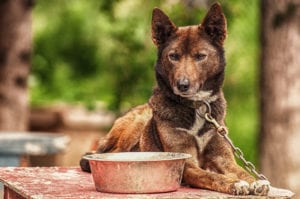
Water should always be available to sled dogs during summer months
We generally give a baited broth once in the morning. Baited broth is basically hot water that has been flavored with something. At our kennel, typically we bait our broth with beef or chicken. We also feed wet meals to ensure our dogs are getting plenty of liquid, even in the summer. Our dogs work in the summer so ensuring they are properly hydrated is important.
The Yukon Quest another 1,000 mile long dog sled race wrote an excellent article about keeping sled dogs hydrated. The article, titled “Water, Water Everywhere” is well worth the read and provides an in-depth look at how sled dogs derive water from food sources such as meat, fish, and fat but also goes in to great detail about how much water a sled dog needs.
Sled Dog Care: Vaccines and Worming
It’s important to keep the dogs healthy. One of the easiest ways to do this is by making sure our sled dogs stay up-to-date on their routine vaccinations and that we regularly worm the dogs. Reputable dog sled races also require that dogs have certain shots in order to compete.
We provide all of our own shots with the exception of the rabies vaccine. The rabies vaccine must be administered by a veterinarian so we have our local vet come to the kennel to administer the vaccine to those dogs that need it. When needed, we take our dogs into the vet.
We hope you enjoyed this post. While it by no means covers everything, we hope we helped provide a good foundation. Stay tuned for Sled Dog Care Part 2 — Taking care of the Dog Team While Out on the Trail.
